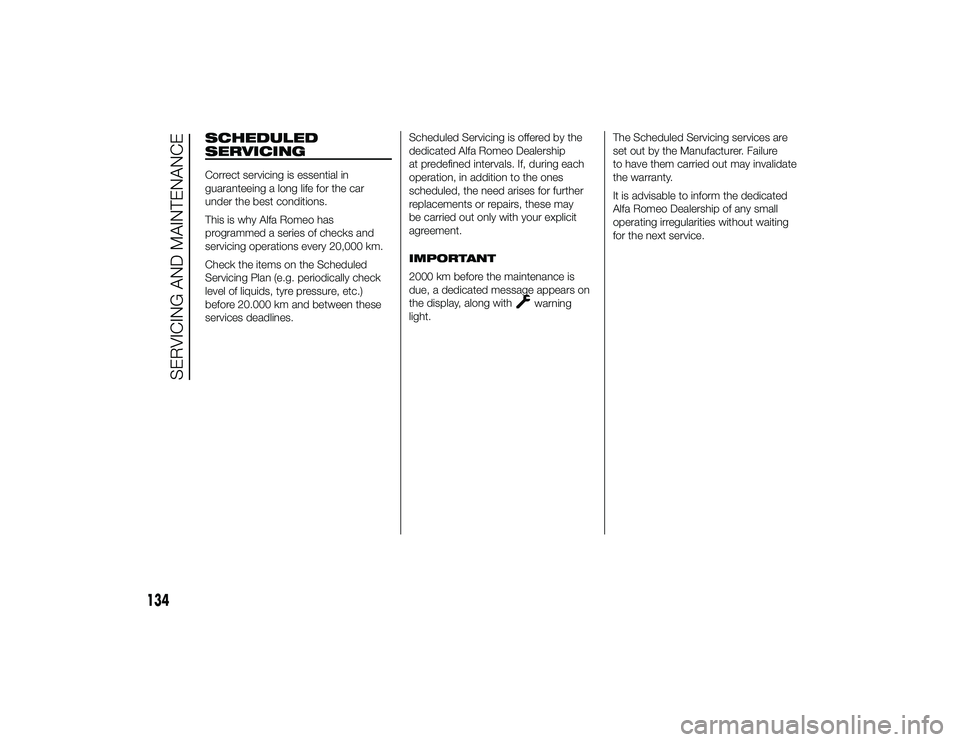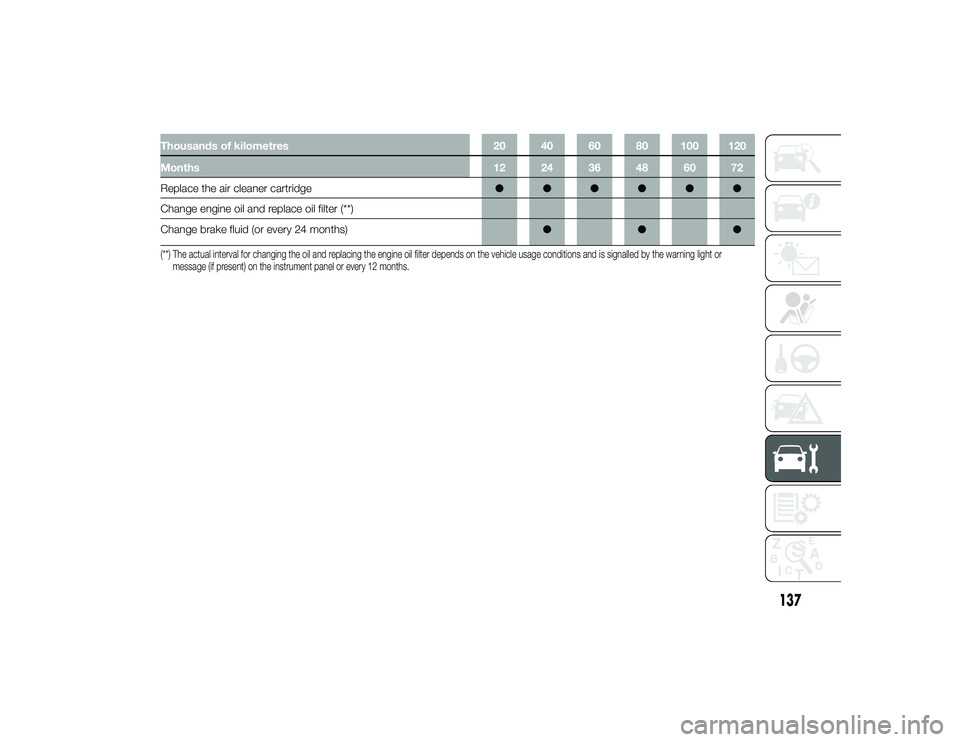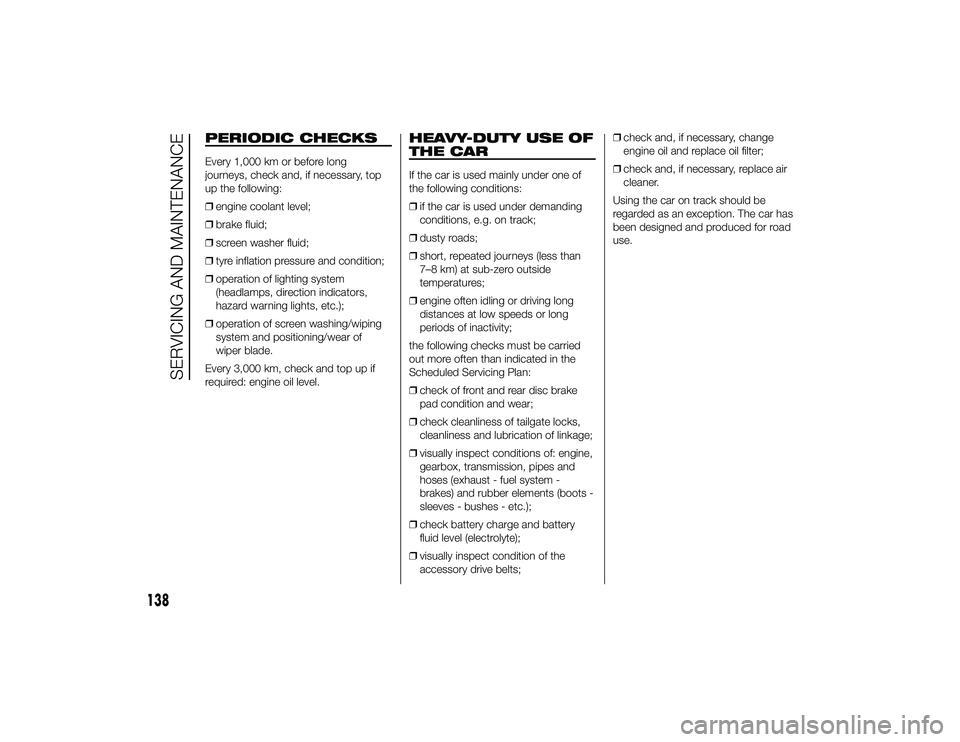warning light Alfa Romeo 4C 2014 Owner handbook (in English)
[x] Cancel search | Manufacturer: ALFA ROMEO, Model Year: 2014, Model line: 4C, Model: Alfa Romeo 4C 2014Pages: 190, PDF Size: 7.87 MB
Page 117 of 190

STARTING THE
ENGINEContact the dedicated Alfa Romeo
Dealership immediately if
warning
light stays on constantly on the
instrument panel.
JUMP STARTING
If the battery is flat, start the engine
using an auxiliary battery with the same
capacity or a little higher than the flat
one.
11)
91)
Proceed as follows to start the car:
❒ connect the positive terminals (+ sign
near the terminal) of the two batteries
with a jump lead fig. 79; ❒
with a second lead, connect the
negative terminal(−)oftheauxiliary
battery to an earthing point
on
the engine or the gearbox/
transmission of the car to be started;
❒ start the engine; when the engine has
started, remove the leads, reversing
the order above.
If after a few attempts the engine does
not start, do not persist but contact
the dedicated Alfa Romeo Dealership.
IMPORTANT Do not connect the
negative terminals of the two batteries
directly! If the auxiliary battery is
installed on another car, check that
there is no accidental contact between
metallic parts of the two cars.
BUMP STARTING
Never, under any circumstances, jump
start the engine by pushing, towing
or coasting downhill.
IMPORTANT
11) Never use a fast battery charger to start the engine as this could
damage the electronic systems
and the ignition and engine supply
control units.
WARNING
91) This procedure must beperformed by qualified personnel
as incorrect actions may cause
high-intensity electrical discharge.
Furthermore, battery fluid is
poisonous and corrosive: avoid
contact with skin and eyes. Keep
naked flames and lit cigarettes
away from the battery and do not
cause sparks.
79
A0L0116
114
IN AN EMERGENCY
24-9-2013 11:50 Pagina 114
Page 120 of 190

WARNING
92) Indicate the presence of thestationary car in accordance with
current regulations: hazard
warning lights, warning triangle,
etc. Those on board should get
out of the vehicle and wait for the
wheel to be repaired away from
the threat posed by the traffic.
If parked on a slope or rough
surface, chock the wheels with
wedges or other suitable devices
(for the correct procedure for
parking the car safely, refer to the
"Parking" paragraph in the
"Starting and driving" chapter).
93) Give the booklet to the technicians who will be handling
the tyre that was treated using
the "Fix&Go automatic" kit.
94) A repair is not possible if the wheel rim is damaged (groove
is deformed, causing air to
escape). Do not remove foreign
bodies (screws or nails) from the
tyre. 95) Do not use the compressor for
more than 20 consecutive
minutes. Risk of overheating. The
kit is not suitable for definitive
repairs, so the repaired tyres may
only be used temporarily.
96) The bottle contains ethylene glycol and latex: it may cause
an allergic reaction. It is harmful if
swallowed. Eye irritant. It may
cause sensitisation if inhaled or
on contact. Avoid contact with
eyes, skin and clothes. In the
event of contact, rinse
immediately with plenty of water.
If ingested, do not induce
vomiting. Rinse out your mouth,
drink large quantities of water and
seek immediate medical attention.
Keep out of the reach of children.
The product must not be used
by asthmatics. Do not inhale the
vapours during insertion and
suction. Call a doctor immediately
if allergic reactions are noted.
Store the bottle in its special
compartment, away from sources
of heat. The sealant has an expiry
date. Replace the bottle if the
sealant has expired.
97) Wear the protective gloves provided with the kit. 98) Apply the adhesive label where it
can be easily seen by the driver as
a reminder that the tyre has been
treated with the quick repair kit.
Drive carefully, especially on
corners. Do not exceed 80 km/h.
Avoid sudden acceleration or
braking.
99) If the pressure has fallen below 1.8 bar, do not drive any further:
the Fix&Go automatic quick tyre
repair kit cannot guarantee proper
hold because the tyre is too
damaged. Contact a dedicated
Alfa Romeo Dealership.
100) Always indicate that the tyre was repaired using the quick
tyre repair kit. Give the booklet to
the personnel charged with
handling the tyre treated with the
repair kit.
117
24-9-2013 11:50 Pagina 117
Page 121 of 190

IMPORTANT
12) Punctures caused by foreignbodies can be repaired if the
damage does not exceed 4 mm on
the tread and on the shoulder of
the tyre. Do not use the repair
kit if the tyre was damaged as a
result of being used when
underinflated.
IMPORTANT
2) Dispose of the bottle and thesealant properly. Dispose of the
components in compliance with
national and local regulations.
CHANGING A BULB
13)101) 102) 103)
GENERAL
INSTRUCTIONS
❒Before changing a bulb check the
contacts for oxidation;
❒ replace blown bulbs with others of
the same type and power;
❒ after replacing a headlight bulb,
always check its alignment;
❒ when a light is not working, check
that the corresponding fuse is intact
before changing the bulb. For the
location of fuses, refer to the
paragraph “If a fuse blows” in this
chapter.
IMPORTANT
13) Halogen bulbs must be handled
by holding the metallic part only.
Touching the transparent part
of the bulb with your fingers may
reduce the intensity of the
emitted light and even reduce the
lifespan of the bulb. In the case
of accidental contact, rub the
lamp with a cloth and spirit and
leave to dry.
WARNING
101) Modifications or repairs to theelectric system that are not
carried out properly or do not take
the system technical
specifications into account can
cause malfunctions leading to the
risk of fire.
102) Halogen bulbs contain pressurised gas; in the case of
breakage they may burst.
118
IN AN EMERGENCY
24-9-2013 11:50 Pagina 118
Page 127 of 190

REAR FOG LIGHT/
REVERSING LIGHT
104)
To replace the rear fog light bulbs A fig.
94 or the reversing lights B fig. 94
proceed as follows:
❒turn the bulb holder C fig. 95
anticlockwise, extract the bulb and
replace it. 3
rd
BRAKE LIGHTS
These are LEDs. For the replacement,
contact the dedicated Alfa Romeo
Dealership.
NUMBER PLATE LIGHTS
To replace the bulbs proceed as
follows:
❒ adjust the lens A in the point shown
in figure fig. 96 laterally to compress
the retaining clip, then pull the
number plate light cluster A out;
❒ turn bulb holder B fig. 97
anticlockwise, extract bulb C and
replace it.
WARNING
104) The rear fog light and the
reversing light are located close to
the exhaust pipes; take the
utmost care not to get burnt
during the bulb replacement.
94
A0L0097
95
A0L0126
96
A0L0136
97
A0L0099
124
IN AN EMERGENCY
24-9-2013 11:50 Pagina 124
Page 137 of 190

SCHEDULED
SERVICINGCorrect servicing is essential in
guaranteeing a long life for the car
under the best conditions.
This is why Alfa Romeo has
programmed a series of checks and
servicing operations every 20,000 km.
Check the items on the Scheduled
Servicing Plan (e.g. periodically check
level of liquids, tyre pressure, etc.)
before 20.000 km and between these
services deadlines.Scheduled Servicing is offered by the
dedicated Alfa Romeo Dealership
at predefined intervals. If, during each
operation, in addition to the ones
scheduled, the need arises for further
replacements or repairs, these may
be carried out only with your explicit
agreement.
IMPORTANT
2000 km before the maintenance is
due, a dedicated message appears on
the display, along with
warning
light. The Scheduled Servicing services are
set out by the Manufacturer. Failure
to have them carried out may invalidate
the warranty.
It is advisable to inform the dedicated
Alfa Romeo Dealership of any small
operating irregularities without waiting
for the next service.
134
SERVICING AND MAINTENANCE
24-9-2013 11:50 Pagina 134
Page 138 of 190

SCHEDULED SERVICING PLAN1750 Turbo Petrol VERSIONSThousands of kilometres20 40 60 80 100 120
Months 12 24 36 48 60 72
Check battery charge status and recharge if necessary ●●●●●●
Check tyre conditions/wear and adjust pressure, if required ●●●●●●
Check operation of lighting system (headlights, direction
indicators, hazard warning lights, luggage compartment,
passenger compartment, glove compartment, instrument panel
warning lights, etc.) ●●●●●●
Check vehicle fastenings ●●●
Check mechanical components fastenings ●●●●●●
Check operation of windscreen wiper/washer system and adjust
jets, if necessary ●●●●●●
Check position/wear of windscreen wiper blade ●●●●●●
Check cleanliness of boot lock, cleanliness and lubrication of
linkages ●●●●●●
Visually inspect condition of: exterior bodywork, carbon
monocoque, aerodynamic bottom, pipes and hoses (exhaust, fuel
supply system, brakes), rubber elements (boots, driveshaft boots,
sleeves, bushes, etc.) ●●●●●●
Check condition and wear of front brake pads and discs, and
operation of pad wear indicator ●●●●●●
135
24-9-2013 11:50 Pagina 135
Page 140 of 190

Thousands of kilometres20 40 60 80 100 120
Months 12 24 36 48 60 72
Replace the air cleaner cartridge ●●●●●●
Change engine oil and replace oil filter (**)
Change brake fluid (or every 24 months) ●●●(**) The actual interval for changing the oil and replacing the engine oil filter depends on the vehicle usage conditions and is signalled by the warning light or
message (if present) on the instrument panel or every 12 months.
137
24-9-2013 11:50 Pagina 137
Page 141 of 190

PERIODIC CHECKSEvery 1,000 km or before long
journeys, check and, if necessary, top
up the following:
❒engine coolant level;
❒ brake fluid;
❒ screen washer fluid;
❒ tyre inflation pressure and condition;
❒ operation of lighting system
(headlamps, direction indicators,
hazard warning lights, etc.);
❒ operation of screen washing/wiping
system and positioning/wear of
wiper blade.
Every 3,000 km, check and top up if
required: engine oil level.
HEAVY-DUTY USE OF
THE CARIf the car is used mainly under one of
the following conditions:
❒ if the car is used under demanding
conditions, e.g. on track;
❒ dusty roads;
❒ short, repeated journeys (less than
7–8 km) at sub-zero outside
temperatures;
❒ engine often idling or driving long
distances at low speeds or long
periods of inactivity;
the following checks must be carried
out more often than indicated in the
Scheduled Servicing Plan:
❒ check of front and rear disc brake
pad condition and wear;
❒ check cleanliness of tailgate locks,
cleanliness and lubrication of linkage;
❒ visually inspect conditions of: engine,
gearbox, transmission, pipes and
hoses (exhaust - fuel system -
brakes) and rubber elements (boots -
sleeves - bushes - etc.);
❒ check battery charge and battery
fluid level (electrolyte);
❒ visually inspect condition of the
accessory drive belts; ❒
check and, if necessary, change
engine oil and replace oil filter;
❒ check and, if necessary, replace air
cleaner.
Using the car on track should be
regarded as an exception. The car has
been designed and produced for road
use.
138
SERVICING AND MAINTENANCE
24-9-2013 11:50 Pagina 138
Page 148 of 190

AIR CLEANERFor cleaner replacement, contact a
dedicated Alfa Romeo Dealership.
BATTERYBattery A fig. 118 does not require the
electrolyte to be topped up with distilled
water. A periodic check carried out at
a dedicated Alfa Romeo Dealership
is, however, necessary to check
efficiency.
REPLACING THE
BATTERY
122) 123) 124) 125)25)4)
If necessary, replace the battery with
another original battery with the same
specifications. Follow the battery
manufacturer's instructions for
maintenance.USEFUL ADVICE FOR
EXTENDING THE LIFE OF
YOUR BATTERY
To avoid draining your battery rapidly
and maintain its efficiency over time,
carefully observe the following
instructions:
❒
when you park the car, ensure that
the doors and tailgate are properly
closed, to prevent roof lights inside
the passenger and luggage
compartments respectively from
staying on;
❒ switch off the roof lights; the car is,
however, equipped with a system
which switches the interior lights off
automatically;
❒ do not keep accessories (e.g. radio,
hazard warning lights, etc.) switched
on for a long time when the engine
is not running;
❒ before performing any operation on
the electrical system, disconnect
the negative battery cable.
IMPORTANT If the charge level remains
under 50% for a long time, the battery
is damaged by sulphation, reducing
its capacity and efficiency at start-up.118
A0L0138
145
24-9-2013 11:50 Pagina 145
Page 152 of 190

NOZZLES
Screen washer
The windscreen washer nozzles are
adjustable fig. 122. They are originally
adjusted at the factory. Should it be
necessary to adjust them again,
contact a dedicated Alfa Romeo
Dealership.
If there is no jet of fluid, firstly check
that there is some fluid in the reservoir
(see paragraph "Checking fluid levels"
in this chapter).
Then check that the nozzle holes are
not clogged; use a needle to unblock
them if necessary.
WARNING
131) Driving with a worn wiper bladeis a serious hazard, because
visibility is reduced in bad
weather.
IMPORTANT
26) Do not operate the screen wiperwith the blades lifted from the
windscreen.
BODYWORKPROTECTION AGAINST
ATMOSPHERIC AGENTS
The car features advanced
technological solutions for effective
protection of the exterior bodywork and
structure.
The best products and best painting
systems lend the exterior bodywork
particularly high resistance to
atmospheric agents (solar radiation,
acid rain, etc.) and gravel, through
specific protections.
The chassis too, in light, corrosion-
resistant alloy, is treated to prevent the
formation of surface oxidation.
CAR CORROSION
WARRANTY
Your car is covered by warranty against
perforation, due to rust, of any original
element of the structure. For the
general terms of this warranty, refer to
the Warranty Booklet.
122
A0L0087
149
24-9-2013 11:50 Pagina 149